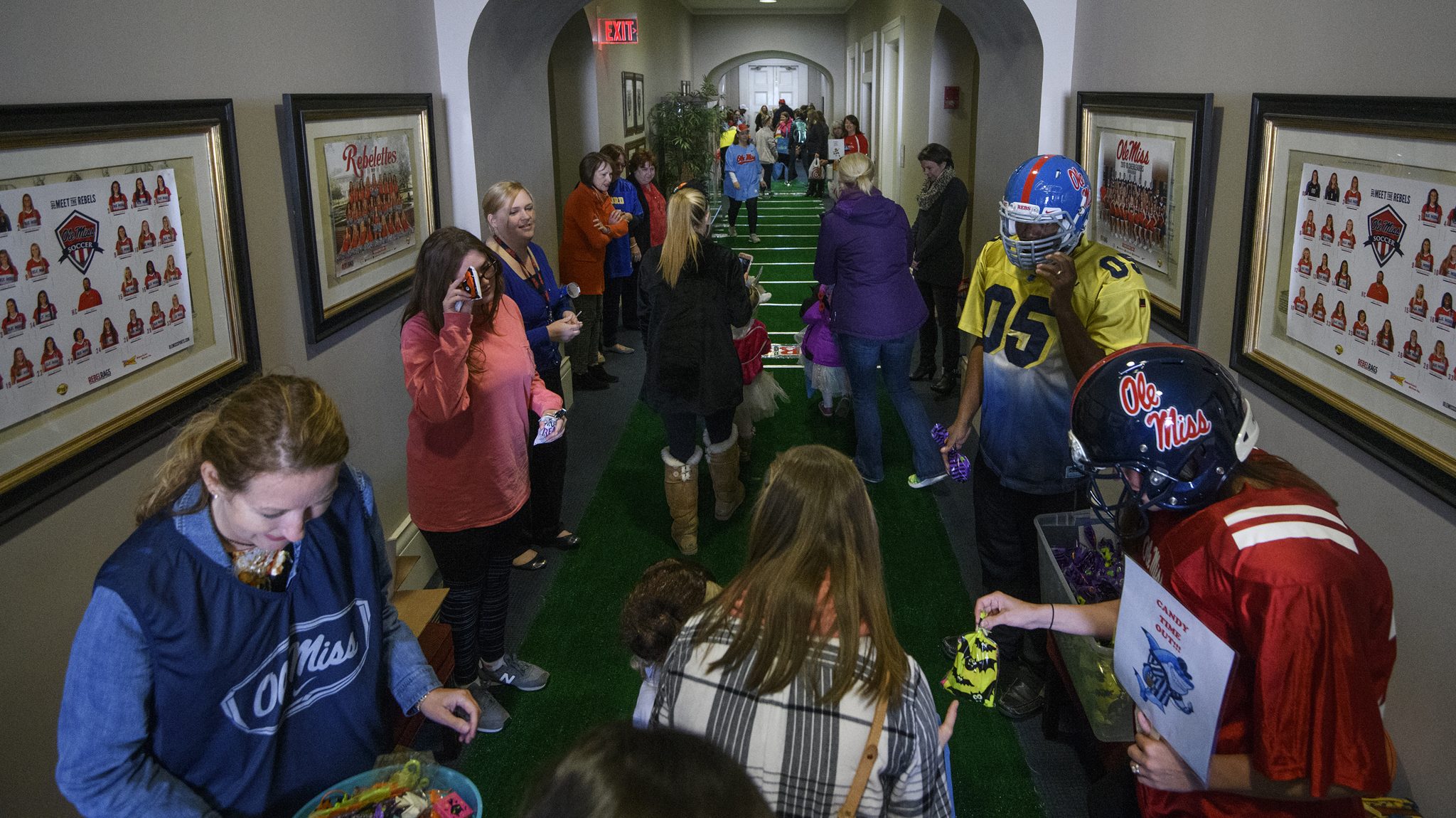
Children from the UM Willie Price Lab School enjoy trick-or-treating with staff members in the Lyceum. Halloween is one of many fall festivals observed in October. Photo by Thomas Graning/Ole Miss Digital Imaging Services
OXFORD, Miss. – With the arrival of autumn comes the observance of several festivals and holidays. As many make plans to participate in these fall celebrations, University of Mississippi religion experts have shared their origins and customs to help enhance the public’s experience of each.
Most religious traditions commemorate both fall and spring seasons with various rituals, marking occasions of harvests and astrological equinoxes. Ancient traditions were intimately linked with the rhythms of the earth.
“With human survival dependent upon adequate harvests, community leaders sought divine aid at these crucial times, creating complex rituals to help secure that aid,” said Mary Thurlkill, professor of religious studies. “Over time, liturgical calendars incorporated autumnal celebrations, including Navaratri/Dasara in Hinduism, Rosh Hashanah and Sukkot in Judaism and Hallowtide in Christianity.”
Halloween, also known as All Hallows’ Eve or All Saints’ Eve, is observed in several countries on Oct. 31, the eve of the Western Christian feast of All Hallows’ Day. It begins the three-day observance of Allhallowtide, the time in the liturgical year dedicated to remembering the dead, including saints, martyrs and all the faithful departed.
“It is widely believed that many Halloween traditions originated from ancient Celtic harvest festivals, particularly the Gaelic festival Samhain,” said Steven Skultety, chair and associate professor of philosophy and religion at Ole Miss. “Samhain itself was Christianized as Halloween by the early church.
“Some believe, however, that Halloween began solely as a Christian holiday.”
Halloween activities include trick-or-treating, attending Halloween costume parties, carving pumpkins into jack-o’-lanterns, lighting bonfires, apple bobbing, divination games, playing pranks, visiting haunted attractions, telling scary stories and watching horror films.
In many parts of the world, the Christian religious observances of All Hallows’ Eve, including attending church services and lighting candles on the graves of the dead, remain popular.
“Some Christians historically abstained from meat on All Hallows’ Eve, a tradition reflected in the eating of certain vegetarian foods on this vigil day, including apples, potato pancakes and soul cakes,” he said.
While the Moon Festival, Sukkoth and Halloween are millennia old, Oktoberfest is a relatively modern fall event. First occurring in 1810, it has become the world’s largest Volksfest, a beer festival and traveling funfair. Held annually in Munich, it is a 16-day folk festival running from mid- or late September to the first weekend in October, with more than 6 million people from around the world attending every year.
Other cities around the world also hold Oktoberfest celebrations, modeled after the original Munich event.
“It’s probably no coincidence that many of our state and county fairs occur around the time of Oktoberfest,” Skultety said. “During the event, large quantities of Oktoberfest beer are consumed.
“Visitors also enjoy numerous attractions, such as amusement rides, sideshows and games. There is also a wide variety of traditional foods available.”
The Mid-Autumn Festival – better known as the Moon Festival – is one of the most important traditional Chinese holidays. Its origin can be traced back to the Zhou dynasty, more than 3,000 years ago in China, but the festival has gradually developed into a major holiday widely celebrated in East Asia and some areas of Southeast Asia.
“Most of the festival’s customs are related to the moon,” said Fei Lan, associate professor of religious studies. “In Chinese culture, the moon has inspired poets and musicians throughout centuries to leave behind thousands of beautiful poems and numerous masterpieces in music about the moon.”
Sukkot, the Jewish Festival of Tabernacles, stems back to Israel in the first millennium, said James Bos, associate professor of religious studies. This year, it began at sunset Oct. 13 and ended at nightfall Oct. 20.
“Sukkot is a biblical Jewish holiday celebrated on the 15th day of the seventh month, Tishrei,” he said. “During the existence of the Jerusalem temple, it was one of the three pilgrimage festivals on which the Israelites were commanded to perform a pilgrimage to the temple.”
Sukkot is a seven-day festival, with the first day celebrated with special prayer services and holiday meals. The seventh day is called Hoshana Rabbah and has a special observance of its own.
During the intermediate days, known as Chol HaMoed, some types of work are forbidden and many businesses are closed.
“Throughout the week of Sukkot, meals are eaten in the sukkah,” Bos said. “Every day, a blessing is recited over the lulav, a closed frond of the date palm tree, and the etrog, the yellow citron.”
Whatever form various fall celebrations may take, Skultety advises safety first.
“Remember, the enjoyment of these festivals and holidays largely depends upon the condition you find yourself in after they’re over,” he said.